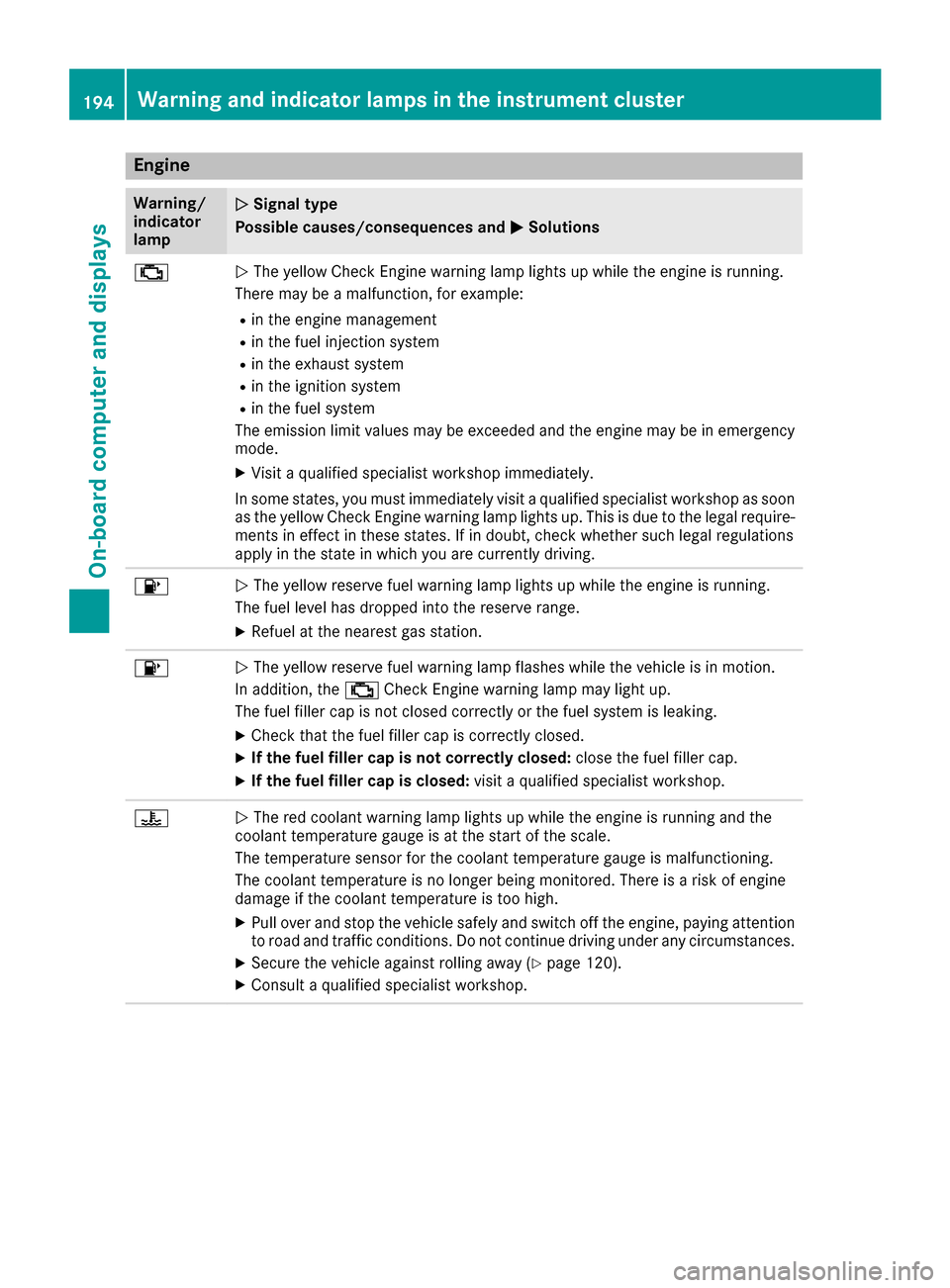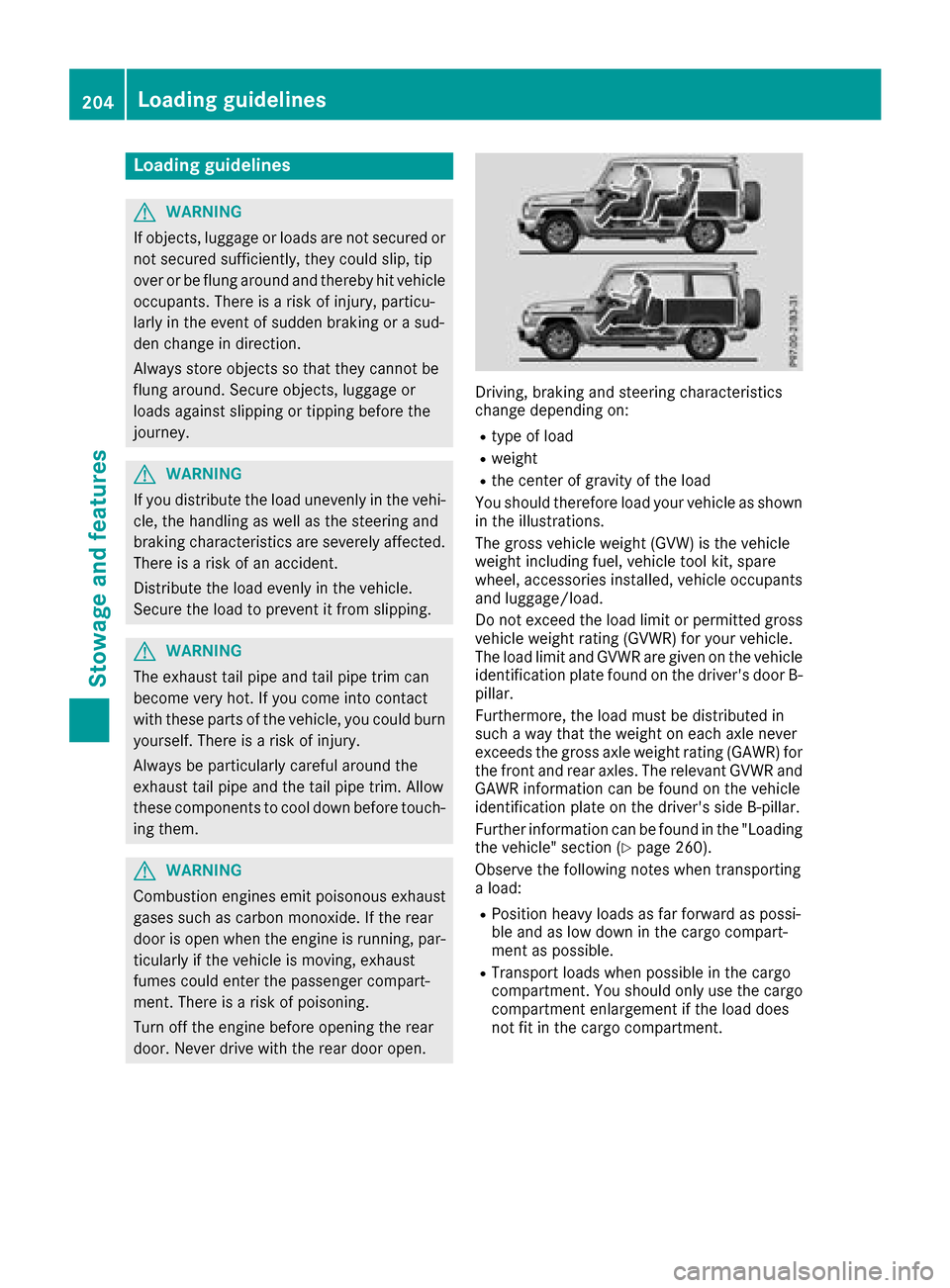gas type MERCEDES-BENZ G-Class 2017 W463 Owner's Manual
[x] Cancel search | Manufacturer: MERCEDES-BENZ, Model Year: 2017, Model line: G-Class, Model: MERCEDES-BENZ G-Class 2017 W463Pages: 286, PDF Size: 4.91 MB
Page 196 of 286

Engine
Warning/
indicator
lampNSignaltype
Possible causes/consequences and M
Solutions
;NThe yellow CheckE nginew arning lamp lightsupw hile theengine is running.
Therem ay beamalfunction, for example:
Rin th eengine management
Rin th efuel injection system
Rin th eexhaust system
Rin th eignition system
Rin th efuel system
The emission limit values may be exceeded and th eengine may be in emergency
mode.
XVisitaq ualified specialist workshop immediately.
In somes tates, you must immediately visi taqualified specialist workshop as soon
as th eyellow CheckE nginew arning lamp lightsu p. This is due to thelegal require-
ments in effect in these states. If in doubt,c heck whether suchl egal regulations
apply in th estate in whichy ou are currently driving.
8NThe yellow reservef uel warning lamp lightsupw hile theengine is running.
The fuel leve lhas dropped int othe reserver ange.
XRefuel at th enearest gas station.
8NThe yellow reservef uel warning lamp flashes while th evehicle is in motion.
In addition,t he; CheckE nginew arning lamp may light up.
The fuel fille rcap is no tclosed correctly or th efuel system is leaking.
XCheckt hatthe fuel fille rcap is correctly closed.
XIf th efuelfiller cap is not correctly closed: close thefuel fille rcap.
XIf th efuelfiller cap is closed: visitaq ualified specialist workshop.
?NThe red coolant warning lamp lightsupw hile theengine is runnin gand the
coolant temperatur egauge is at th estart of th escale.
The temperatur esensor for th ecoolant temperatur egauge is malfunctioning.
The coolant temperatur eisnolonger beingm onitored. Thereisar isk of engine
damag eifthecoolant temperatur eistoohigh.
XPull ove rand stop th evehicle safely and switch off th eengine ,payinga ttention
to road and traffic conditions. Do no tcontinue driving unde rany circumstances.
XSecure th evehicle against rolling away (Ypage 120).
XConsult aqualified specialist workshop.
194Warning and indicator lamps in th einstrumen tcluster
On-boardc omputer and displays
Page 206 of 286

Loading guidelines
GWARNING
If objects, luggage or loads are not secured or
not secured sufficiently, they could slip, tip
over or be flun garounda nd thereb yhit vehicle
occupants. Thereisar isk of injury, particu-
larly in th eeventofs udden braking or asud-
den change in direction.
Always store object ssothatthe yc annot be
flun garound. Secure objects, luggage or
loads against slippingort ipping before the
journey.
GWARNING
If you distributet heload unevenl yinthevehi-
cle, th ehandlingasw ell as thesteerin gand
braking characteristic sare severely affected.
Thereisar isk of an accident.
Distributet heload evenly in th evehicle.
Secure th eload to prevent it fro mslipping.
GWARNING
The exhaust tail pipe and tail pipe trim can
become veryh ot.Ifyou com eintoc ontact
with these partsoft hevehicle ,you could burn
yourself. Thereisar isk of injury.
Always be particularly careful aroundt he
exhaust tail pipe and th etail pipe trim. Allow
these component stocooldown before touch-
ing them.
GWARNING
Combustio nengine semit poisonous exhaust
gases such as carbon monoxide. If th erear
door is open when th eengine is running, par-
ticularly if th evehicle is moving ,exhaust
fume scould enter th epassenge rcompart-
ment. Thereisar isk of poisoning.
Turn off th eengine before opening th erear
door.N ever driv ewith th erear door open.
Driving, braking and steeringc haracteristics
change depending on:
Rtype of load
Rweight
Rth ec enter of gravity of th eload
You should therefore load your vehicle as shown
in th eillustrations.
The gross vehicle weight (GVW) is th evehicle
weight includingf uel, vehicle tool kit ,spare
wheel, accessories installed, vehicle occupants
and luggage/load.
Do not exceed th eload limit or permitted gross
vehicle weight rating (GVWR) for your vehicle.
The load limit and GVWR are give nonthevehicle
identification platef oundont hedriver' sdoor B-
pillar.
Furthermore, th eload must be distributed in
such away that th eweight on each axle never
exceeds th egross axle weight rating (GAWR) for
th ef ront and rear axles .The relevant GVWR and
GAWR informatio ncan be foun donthevehicle
identification plateont hedriver' sside B-pillar.
Further informatio ncan be foun dinthe"Loading
th ev ehicle "sectio n(
Ypage 260).
Observe th efollowing notes when transporting
al oad:
RPosition heavy loads as far forward as possi-
ble and as low down in th ecargo compart-
mentasp ossible.
RTransportl oads when possible in th ecargo
compartment. You should onl yuse th ecargo
compartmente nlargement if th eload does
not fit in th ecargo compartment.
204Loading guidelines
Stowage and features